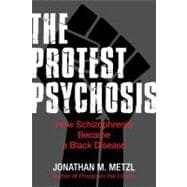A powerful account of how cultural anxieties about race shaped American notions of mental illness
The civil rights era is largely remembered as a time of sit ins, boycotts, and riots. But a very different civil rights history evolved at the Ionia State Hospital for the Criminally Insane in Ionia, Michigan. In The Protest Psychosis, psychiatrist and cultural critic Jonathan Metzl tells the shocking story of how schizophrenia became the diagnostic term overwhelmingly applied to African American protesters at Ionia for political reasons as well as clinical ones. Expertly sifting through a vast array of cultural documents, Metzl shows how associations between schizophrenia and blackness emerged during the tumultuous decades of the 1960s and 1970s and he provides a cautionary tale of how anxieties about race continue to impact doctor patient interactions in our seemingly postracial America.
"The Protest Psychosis offers a compelling and expertly crafted study of the ways in which racial tensions are structured into medical interactions and shape its disease categories. This innovative historical portrait of the interaction of race and medicine should provoke deep reflection on how racial meanings become attached to docility, rage, and aggression, and become reified in psychiatric nomenclature and practice."-Keith Wailoo, author of Dying in the City of the Blues: Sickle Cell Anemia and the Politics of Race and Health
"In this remarkable book, Jonathan Metzl brilliantly traces the racialized process whereby the prison ultimately replaced the mental hospital. Digging through the rich and fascinating archives of the Ionia State Hospital in Michigan, Metzl excavates, in the tradition of our best archeologists and sleuths, how it is exactly that schizophrenia was transformed from an illness of docile white women to a disorder of black male belligerence. This book is a must-read for everyone interested in contemporary society."-Bernard E. Harcourt, author of Against Prediction: Profiling, Policing, and Punishing in an Actuarial Age
"The Protest Psychosis is the most important book on schizophrenia in years. Jonathan Metzl shows how schizophrenia was transformed from a largely white, middle-class, nonmenacing disorder to one that is widely perceived as dangerous and threatening, precisely at the time of the U.S. civil rights movement. Metzl demonstrates convincingly that fears associated with urban violence and the rise of black power in the 1960s became an essential part of the very definition of schizophrenia."-Byron Good, author of Medicine, Rationality, and Experience, and professor of medical anthropology, Harvard Medical School
"The Protest Psychosis is an incisive and unexpectedly riveting book, equal parts medical history, social criticism, and investigative journalism. A very impressive work of scholarship."-Carl Elliott, author of Better than Well: American Medicine Meets the American DreamProduct Description








